
Sydney Rows
A Centennial History of the Sydney Rowing Club, 1970, by A L May
Table of Contents
Chapters
- Preliminaries: before 1870
- Foundations: 1870-1880
- New Clubs: 1880-1890
- The Amateur Question: 1890-1900
- Sydney on Top: 1900-1910
- Henley and War: 1910-1920
- Pearce and Mosman: 1920-1930
- Financial Problems: 1930-1940
- War and Wood: 1940-1950
- Strength and Stability: 1950-1960
- On Top Again: 1960-1970
Appendices
11. On Top Again: 1960-1970
Chapter Eleven page 1 2 3 4 5 6
NSW won every event at the 1967 King's Cup carnival at Murray Bridge. Bruce Evans and Eric Longley were appointed the State selectors, along with Lance Robinson and Bert Harding, the respective coaches. For the eight, they chose Brazenall, Hayes, Ian McWhirter, Freeman, Denny and Thomas (cox) of Haberfield, along with Stevens, Peter Dickson and Duval (giving the latter his sixth successive King's Cup selection). Bob Powell was selected in the lightweight four together with Krause, Bullard and Faddy of Haberfield, while Grover was selected as cox and Dennis Carmody as emergency. Through his win in the sculls, Shirlaw gained the right to represent the State for the fourth time.
In SA itself, the eight won by 1 1/4 lengths from Tasmania and SA. Victoria was out of a place for the first time since 1948. In the Penrith Cup, NSW led from start to finish to beat SA by 2 1/2 lengths with Victoria third. Shirlaw showed a big improvement to record a very convincing 4 lengths win in the final of the President's Cup, with Sykes second and Moore third.
The most extensive tour ever undertaken by Australian rowers was now in prospect. An invitation to Australia to compete at the Canadian Henley regatta later in 1967 had been accepted and the King's Cup and President's Cup were trials for this honour. Further test races were held at Penrith late in May, with the NSW eight, rowing in two fours, winning both the coxless and coxed fours and Guest and Ramage of Victoria winning both the coxed and coxless pairs. The selectors decided, however, to send the Victorian coxed four of Gillon, Douglas, Harry, Boykett and Daffy (cox) which had finished second in the trial as a third crew. In the quest for further international experience, it was agreed that the crews race in the North American and US national titles and in the European Championships in Vichy, France. The honour and hard work of the manager's position fell to Laurie Stepto of NSW.
A number of changes were made to the eight before it left Australia. Dickson and Brazenall were replaced by Reg Free of Tasmania, who had been invited to take part in trials, and Morgan of Sydney. When the coxswain, Thomas, was unable to make the trip, Grover took his place.
Australia came second to the University of British Columbia in the eights at the Royal Canadian Henley at St. Catharines, while the four scored a good win. Eighteen nations took part in the North American championships on the same course a fortnight later. The coxed four won its heat and scored a good win in the final from USA and Denmark.
The eight finished only third in the heat behind NZ and West Germany, but won the repechage to enter the final. This was won again by NZ, but Australia displaced West Germany to gain second place. Shirlaw failed to make the final of the sculls, but did have the satisfaction of winning the little final. In the United States nationals, the four was second in the final to NZ and the eight was unplaced. It was then on to Vichy for the Australian representatives, where 25 countries were represented (NZ's great eight, unfortunately, not being present).
The performance of the Australians was below that of St. Catharines but still most promising. The four came second in the heat and second in the repechage. They were eliminated in the semi-final but finished second in the little final to rank eighth overall. The eight was beaten in the heat by East Germany but won the repechage to enter the final. Here they finished only sixth, though leading early, with West Germany winning from USA and USSR. Shirlaw was a scratching from the sculls.
The remainder of the 1967/68 season was also exciting. This was due, particularly, to the tour of NZ scheduled for the first half and the selections for the Mexico City Olympics that would hinge significantly on the outcome of the 1968 King's Cup. The first regatta of the season was the Sydney Waratah Spring Festival regatta, organized by SRC on behalf of the NSWRA. The club was successful in winning the Sydney Waratah Shield for the most successful club for the third time in three regattas. Presentation of sets of oars by the two Sydney boatbuilding firms for the CHS fours and the maiden fours for unlicensed clubs was again a feature of the regatta.
Selection trials for the NZ tour took place early in the season, with many of the Australian representatives of the Canada - Vichy squad unavailable. The coxed four test race was won by a Sydney crew composed of Duval, Fazio, Mackney, Morgan and Grover (cox) and they won selection along with a Victorian eight and pair oar and Peter Edwards, the winners of other test races.
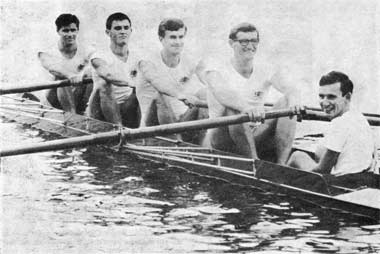
The Australian coxed four for the New Zealand tour of 1967
Joe Fazio (bow), Kim Mackney, Michael Morgan, Alf Duval (stroke), Alan Grover (cox)
A trial was also held for a lightweight four to represent NSW in races in NZ at the same time-the first opportunity for lightweights to tour-and the Sydney crew of Bob Tagg, the Carmodys and Graham Williams with Kevin Hollingworth cox gained selection after a 5 length victory. Sixteen "tests" were conducted during the 22-day tour, with NZ winning the series and the Ampol Trans-Tasman Trophy by 10 events to 6. In lightweight events during the tour, the Sydney four was unbeaten, giving some very impressive performances.
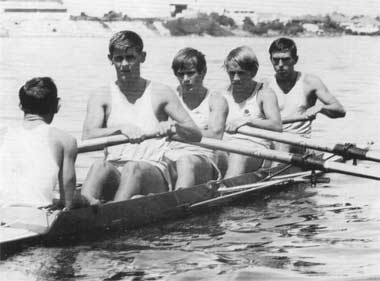
The Sydney lightweight four which toured New Zealand in 1967
To improve prospects for Olympic selection, the RA decided to approve entries from composite crews for senior races in 1967/68. Both John Ranch and Gary Pearce, who had earlier applied unsuccessfully to the Association for transfers to Sydney, then joined Sydney members in composite crews which were to prove highly successful. The four of Nickson (bow), Farrell, Ranch, Pearce (stroke) and Chessell (cox) had a number of wins, but it was the all-Sydney coxed four of Fazio (bow), Mackney, Morgan, Duval (stroke) and Grover (cox) which won the champion fours of NSW. When these two fours were put together for the champion eights of NSW in February, 1968, they proved far too good for the opposition and won from Mosman by 3 1/2 lengths in the time of 5.55.9.
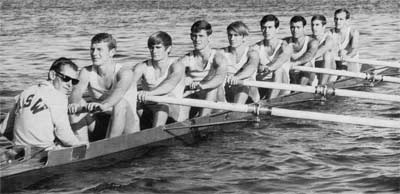
Champion lightweight eight of 1967-68
D Tagg (bow), R Allen, A Phillips, G Williams, I Carmody, R Tagg, D Carmody, R Latham (stroke), K Hollingworth (cox)
Sydney's lightweights also had a grand year, their wins including four championships: the coxed four, coxless four, coxed pair and, later in the season, the eight. Sydney also had considerable success in the junior division with a number of wins in fours and eights culminating, in April, with a win in the champion junior eights of NSW. The crew for the latter event was boated Mark Hill (bow), Lee England, Peter Johnston, Stan Perkowicz, Guy Horsley, John May, Graham Hartman, Darryl Letch (stroke) and Ian Chessell (cox).
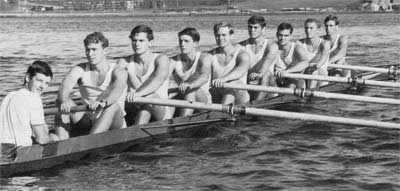
The champion junior eight of 1967-68
M Hill (bow), L England, P Johnston, S Perkowicz, G Horsley, J May, G Hartman, D Letch (stroke), I Chessell (cox)
Late in the season, too, a maiden eight comprising Larry Favaloro (bow), Andy Favaloro, Bruce O'Meagher, Martin Kerr, Ron Hyslop, James Meredith, John Taylor, Ian Falson (stroke) and Rick Armstrong (cox) had several good wins.
The 1968 King's Cup was due to be held at Lake Wendouree but a quite unprecedented position arose. Due to severe drought, the water in the lake was insufficient to stage the events and, six weeks before the due date, the VRA requested the NSWRA to conduct the events at Penrith (with the 1970 carnival, which NSW was due to hold, being transferred to Victoria). NSW and the other States agreed to the change, although the always burdensome task of staging the events was now to be accentuated due to the restricted time available. The assistance of the firm of W.D. and H.O. Wills in sponsoring the regatta did, however, ease the burden considerably. The NSW selectors, Howard Holden and Bruce Evans, made only two changes to the champion eight, with Farrell and Mackney yielding their seats to Peter Dickson and a newcomer, John Clarke of Mosman.
With Phil Cayzer absent overseas, the coaching of the crew was undertaken by Alan Callaway. The lightweight four selected was Pat Hannan of Drummoyne (bow), Ian Carmody, Bob Tagg, Dennis Carmody (stroke), Kevin Hollingworth (cox) and Graham Williams (emergency). Dick Reddel of Haberfield qualified to represent NSW in the sculls by beating Shirlaw, the Australian title holder, in the State championships.
The NSW eight succeeded in winning the King's Cup, but only by 1 second from a strong Victorian crew, with Tasmania well back third. The time was a very fast 5.46.9. The Penrith Cup was a thrilling event, with the NSW four producing an amazing finish to overhaul Victoria and to win by 3 feet. SA was third. Reddel was unwell on the day and finished only fourth in the sculls behind Kert of Queensland, Edwards of Victoria and Winter of Tasmania.
Trials for the other five Olympic classes of boat were held at the Australian National Regatta at Murray Bridge in May, 1968. The grading committee of Bob Aitken (Victoria), Bill Wallace (SA) and Maurie Grace (NSW) were present to gauge performances. The outstanding effort was by Guest and Ramage of Victoria in winning the coxless pair and they were also members of the winning coxless four. The pair was graded second overall behind the NSW eight, the coxless four third and the Victorian coxed four, winners of the North American championships, only fourth. Kert, the sculler, was assessed fifth. Actual selections were severely limited, however.
The total Australian Olympic team was restricted to 180 and rowing did well, in view of the 1964 results, to gain 16 places for oarsmen (plus a coach and team manager). The grading committee recommended and it was accepted that the eight, plus cox and two emergencies, and the pair-oar form Australia's team, along with Alan Callaway and Bob Hemery (manager), the three other rowing places being foregone. Experimentation to find the best possible eight continued during training for the Olympics and two changes were finally made. Dave Douglas of the Victorian eight and coxed four went into the crew along with Bob Shirlaw, while Clarke and Nickson were relegated to the emergency positions.
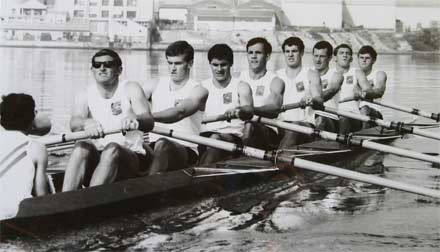
1968 Olympic Eight training in Sydney
The final crew averaged 13 stone 11 lb. in weight and 6' 2 1/2 " in height. They undertook probably the most gruelling conditioning programme ever undertaken by an Australian crew. An idea of their ability was gained in the Sydney-to-Haberfield Head of the River when, under "shocking weather conditions with many crews swamping", the crew rowed the course in 23.40 to take 25 seconds off the record. On the eve of departure, the rowing section was hailed as the fittest athletes in the entire Australian team. Their chances were also enhanced by a specially built Sargent and Burton boat, constructed after extensive and costly experimental work by the firm.
Australia's greatest-ever rowing performance was recorded at the 1968. Mexico City Olympics. The racing took place on a man-made canal at Cuemanco, near Xochimilco, under excellent conditions but at an altitude of 7300 feet. In its heat of the eights, Australia finished second to West Germany by just under a length, while NZ won the other heat. The winning crews went into the final, with Australia soon following them through a win in the repechage over Russia. Czechoslovakia and USA qualified by finishing first and second in the other repechage.
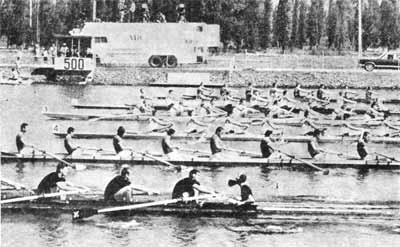
The start of the Olympic eight final
From the camera the crews are New Zealand, Czechoslovakia, Australia, West Germany, USA and USSR
There were three heats of the coxless pair, and the Australians were content to enter the semi-finals by finishing second to USA in the heat. In the semi-final, however, they were almost a length in front at the 1800 metres mark when Ramage partially collapsed (one of 40 cases of collapse during or after races). Three crews raced past the Australians to put them out of the final (although they still recorded a 7 seconds faster time than the winning crew in the second semi-final). Some prestige was regained when the pair, fully recovered, won well in the little final.
Over 40,000 people filled the stands and lined the sides of the course for the final of the eights. Australia's well-planned tactics were to settle down for the first 800 metres at a reduced pressure to conserve energy and then produce a final sprint. NZ led at the half-way from West Germany with Australia fifth. At the 1500 metre mark, Australia had passed USA to gain fourth place. The crew then spurted past Russia and then NZ and stroke by stroke pegged back the high-rating West Germans. They failed to overtake them by just 0.98 of a second, with Russia beating NZ for third place. The winning time of 6.07 was judged to be equivalent to about 5.50 in dead conditions at sea level.
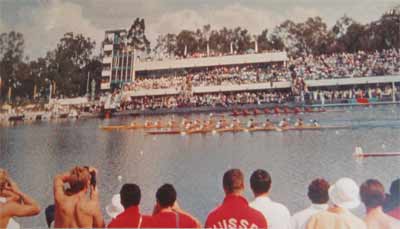
Nearing the finish of the Olympic men's eight final
Of the other Olympic titles, Wienese of Holland won the sculls, East Germany the coxless four and coxless pair, Italy the coxed pair, Russia the double sculls and NZ the coxed four.
